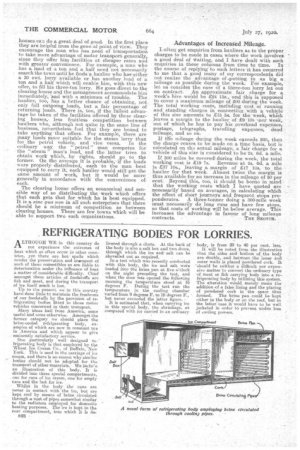REFRIGERATING BODIES FOR LORRIES.
Page 26

If you've noticed an error in this article please click here to report it so we can fix it.
ALTHOUGH WE in this country do not experience the extremes of heat which so often occur in other countries, yet there are hot • spells which render the preservation and transport of such of those comestibles. as are liable to deterioration under the influence of heat a matter of considerable difficulty. Chief amongst these articles of foodstuffs are fish and meat, and during the transport of ice itself much is lost.
Up to the present we in this country have done little to maintain the freshness of our foodstuffs by the provision of refrigerating bodies fitted to those motor vehicles concerned in their transport.
Many ideas hail from America, some useful and some otherwise. Amongst the former category we should place the brine-cooled refrigerating body, examples of which are now in constant 'aE0 in .America and which appear to giVe eminently 'satisfactory service. One particularly well' designed refrigerating body is that employed by tile Wheat Ice Cream Co., of Buffalo, New York. This is used in the carriage of ice cream, and there is no reason why similar bodies should not be adopted for the transport of other materials. We incin:,'e an illustration of this body. It is divided into three special compartments, one for cans of ice cream, one for empty cans and the last for ice; Whilst in the body the cans are never in contact with the ice, but are kept cool by means of brine circulated through a nest of pipes somewhat similar to the radiators employed for domestic heating purposes. The ice is kept in the rear compartment, into which it is de livered through a chute. At the back of the body is also a salt box and two doors, through which the ice andsalt can be shovelled out as required. In a test which was recently conducted with this body, the ice and salt were -loaded into the brine pan at five o'clock on the night preceding the test, and when the door was opened the following morning the temperature stood at 16 degrees F. During the test run the temperature in the cooling chamber varied from 9 degrees F. to 16 degrees F., but never exceeded the latter figure.
It is estimated that, when carrying ice in this special body, the shrinkage, as compared with ice carried in an ordinary body, is from 20 to 40 per cent. less.
It will be noted from the illustration that the sides and bottom of, the body are double, and between the inner and outer walls is placed powdered cork. It 'should be neither a difficult nor expensive matter to convert the ordinary type of meat or fish carrying body into a refrigerating body by utilizing this system. The alteration would merely mean the addition of a false lining and the placing of powdered cork in the space thus formed. The brine pan could be kept either in the body or on the roof, but in the latter case it would have to be well jacketed in order to prevent unclne loss of coaling powers.




























